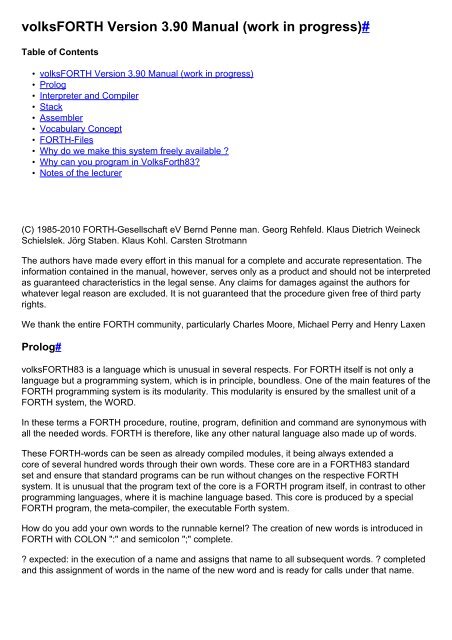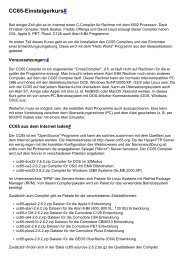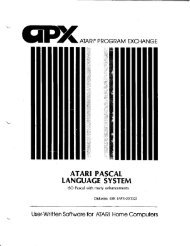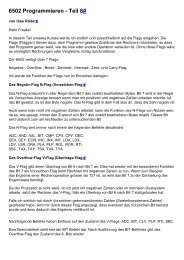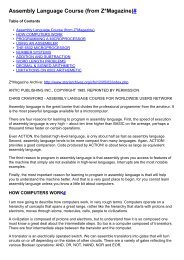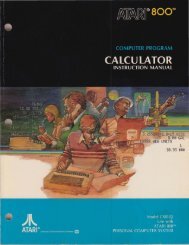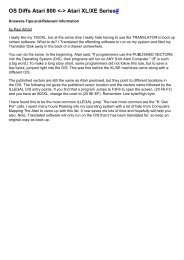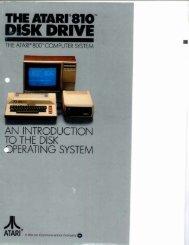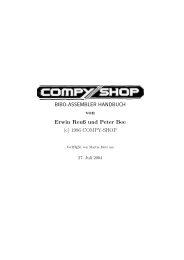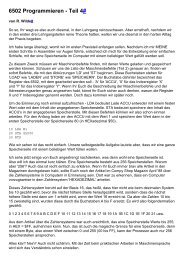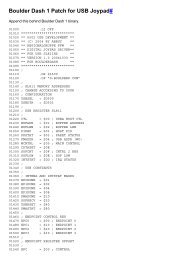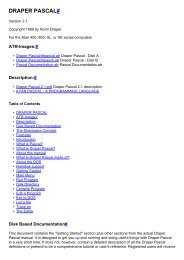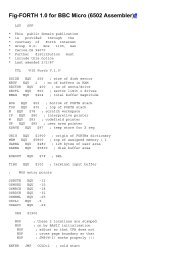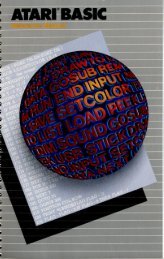volksFORTH Version 3.90 Manual (work in progress)# - Strotmann.de
volksFORTH Version 3.90 Manual (work in progress)# - Strotmann.de
volksFORTH Version 3.90 Manual (work in progress)# - Strotmann.de
You also want an ePaper? Increase the reach of your titles
YUMPU automatically turns print PDFs into web optimized ePapers that Google loves.
<strong>volksFORTH</strong> <strong>Version</strong> <strong>3.90</strong> <strong>Manual</strong> (<strong>work</strong> <strong>in</strong> <strong>progress</strong>)#<br />
Table of Contents<br />
• <strong>volksFORTH</strong> <strong>Version</strong> <strong>3.90</strong> <strong>Manual</strong> (<strong>work</strong> <strong>in</strong> <strong>progress</strong>)<br />
• Prolog<br />
• Interpreter and Compiler<br />
• Stack<br />
• Assembler<br />
• Vocabulary Concept<br />
• FORTH-Files<br />
• Why do we make this system freely available <br />
• Why can you program <strong>in</strong> VolksForth83<br />
• Notes of the lecturer<br />
(C) 1985-2010 FORTH-Gesellschaft eV Bernd Penne man. Georg Rehfeld. Klaus Dietrich We<strong>in</strong>eck<br />
Schielslek. Jörg Staben. Klaus Kohl. Carsten <strong>Strotmann</strong><br />
The authors have ma<strong>de</strong> every effort <strong>in</strong> this manual for a complete and accurate representation. The<br />
<strong>in</strong>formation conta<strong>in</strong>ed <strong>in</strong> the manual, however, serves only as a product and should not be <strong>in</strong>terpreted<br />
as guaranteed characteristics <strong>in</strong> the legal sense. Any claims for damages aga<strong>in</strong>st the authors for<br />
whatever legal reason are exclu<strong>de</strong>d. It is not guaranteed that the procedure given free of third party<br />
rights.<br />
We thank the entire FORTH community, particularly Charles Moore, Michael Perry and Henry Laxen<br />
Prolog#<br />
<strong>volksFORTH</strong>83 is a language which is unusual <strong>in</strong> several respects. For FORTH itself is not only a<br />
language but a programm<strong>in</strong>g system, which is <strong>in</strong> pr<strong>in</strong>ciple, boundless. One of the ma<strong>in</strong> features of the<br />
FORTH programm<strong>in</strong>g system is its modularity. This modularity is ensured by the smallest unit of a<br />
FORTH system, the WORD.<br />
In these terms a FORTH procedure, rout<strong>in</strong>e, program, <strong>de</strong>f<strong>in</strong>ition and command are synonymous with<br />
all the nee<strong>de</strong>d words. FORTH is therefore, like any other natural language also ma<strong>de</strong> up of words.<br />
These FORTH-words can be seen as already compiled modules, it be<strong>in</strong>g always exten<strong>de</strong>d a<br />
core of several hundred words through their own words. These core are <strong>in</strong> a FORTH83 standard<br />
set and ensure that standard programs can be run without changes on the respective FORTH<br />
system. It is unusual that the program text of the core is a FORTH program itself, <strong>in</strong> contrast to other<br />
programm<strong>in</strong>g languages, where it is mach<strong>in</strong>e language based. This core is produced by a special<br />
FORTH program, the meta-compiler, the executable Forth system.<br />
How do you add your own words to the runnable kernel The creation of new words is <strong>in</strong>troduced <strong>in</strong><br />
FORTH with COLON ":" and semicolon ";" complete.<br />
expected: <strong>in</strong> the execution of a name and assigns that name to all subsequent words. completed<br />
and this assignment of words <strong>in</strong> the name of the new word and is ready for calls un<strong>de</strong>r that name.
Interpreter and Compiler#<br />
A classic FORTH system is always both an <strong>in</strong>terpreter and a compiler. After E<strong>in</strong>schaltmeldung or<br />
press<strong>in</strong>g the button wait<strong>in</strong>g for the FORTH <strong>in</strong>terpreter with the FORTH-typical "ok" for your <strong>in</strong>put. You<br />
can write one or more command words <strong>in</strong> a cell. <strong>volksFORTH</strong> starts after press<strong>in</strong>g the return key<br />
with his <strong>work</strong> <strong>in</strong> help<strong>in</strong>g processed by the series after each command <strong>in</strong> the command l<strong>in</strong>e. These<br />
command words are <strong>de</strong>limited by spaces. The <strong>de</strong>limiter (Limiter) for FORTH procedures is, therefore,<br />
the space, which also has the syntax of the language FORTH would be <strong>de</strong>scribed.<br />
The compiler <strong>in</strong> a FORTH system is thus part of the <strong>in</strong>terpreter <strong>in</strong>terface. There is therefore no<br />
compilation process to create the co<strong>de</strong>, as <strong>in</strong> other compiled languages, but the <strong>in</strong>terpreter is secured<br />
with new words as necessary to solve the problems the user programs.<br />
Even ":" (COLON), and ";" (semicolon) are compiled words, which turn off the compiler for the system<br />
on and off. S<strong>in</strong>ce even the words. control the compiler, "normal"-FORTH words are miss<strong>in</strong>g from the<br />
usual FORTH compiler options <strong>in</strong> other languages or compiler switches. The FORTH compiler is<br />
controlled by FORTH-words.<br />
The call of a FORTH-word is by its name without an explicit CALL or GOSUB. This leads to the<br />
FORTH-typical appearance of the word <strong>de</strong>f<strong>in</strong>itions:<br />
: <br />
... ;<br />
The standard system response <strong>in</strong> FORTH is the famous "ok". There is no requirement characters<br />
like 'A>' for DOS or ']' <strong>in</strong> good APPLE 11 is not it! This can lead to. that after a successful action, the<br />
screen completely blank, true to the motto:<br />
No News Is Always Good News!<br />
And - unusually - FORTH used the so-called Postfix Notation (RPN) is similar to HP calculators,<br />
which <strong>in</strong> some circles are very popular. This means FORTH always expects only the arguments, the<br />
action ... Instead of<br />
3 + 2 and (5 + 5) * 10<br />
It means<br />
2 3 + and 5 5 + 10 *<br />
S<strong>in</strong>ce the expressions are evaluated from left to right, there are no brackets <strong>in</strong> FORTH.<br />
Stack#<br />
Equally unusual is that FORTH performs only actions explicitly requested: the result of your<br />
calculations will rema<strong>in</strong> <strong>in</strong> a special area of memory, the stack, right up there with an output<br />
command (usually "will.") Issued on then screen or pr<strong>in</strong>ter. As the words of the FORTH-subrout<strong>in</strong>es<br />
and functions meet other programm<strong>in</strong>g languages, they also need the ability to receive data to<br />
process and store the result. This function takes the STACK. In FORTH parameters for procedures<br />
are often stored <strong>in</strong> variables, but mostly passed on the stack.<br />
Assembler#<br />
With<strong>in</strong> a FORTH environment can be <strong>in</strong>stantly programmed <strong>in</strong>to the mach<strong>in</strong>e language of the<br />
processor without hav<strong>in</strong>g to leave the <strong>in</strong>terpreter must. Assembler <strong>de</strong>f<strong>in</strong>itions are the equivalent<br />
programs FORTH FORTH-words.
Vocabulary Concept#<br />
The state-FORTH has an advanced vocabulary structure that was proposed by W. Ragsdale. This<br />
vocabulary-concept allows the classification of the FORTH-words <strong>in</strong> logical groups.<br />
This allows you to switch on when nee<strong>de</strong>d and necessary commands disconnect<strong>in</strong>g after use. In<br />
addition, the vocabularies allow the use of the same name for different words, without gett<strong>in</strong>g <strong>in</strong>to a<br />
name conflict. An approach <strong>in</strong> action ühnliche catfish offers the UNIT-concept or MODULA PASCAL<br />
compiler or the packages <strong>in</strong> Java.<br />
FORTH-Files#<br />
FORTH often uses special files for its programs. This is a historical basis and the legacy of a tent<br />
when Porth very often took over functions of the operat<strong>in</strong>g system. S<strong>in</strong>ce there were only FORTH<br />
systems, the mass completely without even a DOS operat<strong>in</strong>g system or <strong>in</strong>terven<strong>in</strong>g management and<br />
file structures for your own use. These files are so-called block files and consist of a series of large<br />
blocks of 1024 bytes. Such a block, which is often called SCREEN is the basis of the source text<br />
edit<strong>in</strong>g <strong>in</strong> FORTH. However, with the volks4TH normal files can be edited <strong>in</strong> the format of the native<br />
operat<strong>in</strong>g system (MS-DOS, Atari TOS, Apple DOS, AMS-DOS, CP / M there ...), so-called "stream<br />
flow".<br />
In general, any language is beh<strong>in</strong>d a certa<strong>in</strong> concept, only with knowledge of this concept is possible<br />
to use a language effectively. The language concept of FORTH is <strong>de</strong>scribed <strong>in</strong> the book "In FORTH<br />
th<strong>in</strong>k '(Th<strong>in</strong>k<strong>in</strong>g Forth) by Leo Brodie (Hanser Verlag).<br />
A first impression of <strong>volksFORTH</strong>83 and our pri<strong>de</strong> <strong>in</strong> this prologue is <strong>in</strong>ten<strong>de</strong>d to provi<strong>de</strong>.<br />
<strong>volksFORTH</strong>83 is an "open source" system, with its performance, the question arises:<br />
Why do we make this system freely available #<br />
The spread, which has found the language FORTH was significantly l<strong>in</strong>ked to the existence of<br />
figFORTH. Also figFORTH is an open-source program (previously this was called public doma<strong>in</strong>, but<br />
today the term is open-source more accurate), ie it must be <strong>in</strong>clusive of the source text passed and<br />
copied. Nevertheless wereunfortunately various provi<strong>de</strong>rs to easily adapt the figFORTH on different<br />
computers can pay very expensive.<br />
Established <strong>in</strong> 1979, published figFORTH is no longer the case currently, as caused by the further<br />
spread of Forth an abundance of elegant approaches, some of Forth83 <strong>in</strong> the standard and the ANSI<br />
Forth Standard have been <strong>in</strong>clu<strong>de</strong>d. It was then of Laxen and Perry wrote the F83 and dissem<strong>in</strong>ated<br />
as a public Domaln. This free-FORTH '83 standard for MS-DOS, with its numerous utilities quite<br />
complex and is not available with manual.<br />
We have <strong>de</strong>veloped a new Forth for different computers. The result is the <strong>volksFORTH</strong>83, one of the<br />
best Forth systems, there is. The state-FORTH is to build <strong>in</strong> the tradition of the above systems, <strong>in</strong><br />
particular the F83, and promote the spread of the language FORTH.<br />
state-FORTH FORTH was ultra un<strong>de</strong>r the name <strong>in</strong>itially written for the C64. After publication of the<br />
Atari ST computer series, we <strong>de</strong>ci<strong>de</strong>d to <strong>de</strong>velop it for a <strong>volksFORTH</strong>83. The first shipped version 3.7<br />
was that concerned editor and mass storage, still heavily based on the C64. It conta<strong>in</strong>ed, however,<br />
have an improved tracer, the GEM library and other tools for the ST. The next step consisted <strong>in</strong> the<br />
<strong>in</strong>tegration of the operat<strong>in</strong>g system files. Source texts could now be processed from the <strong>de</strong>sktop and<br />
other utilities. The third adaptation of the state-FORTH was <strong>de</strong>signed for the CP / M mach<strong>in</strong>e (8080<br />
processors), which is specifically for Schnei<strong>de</strong>r CPC also supports the graphics capability. Then the<br />
state-FORTH for wi<strong>de</strong>spread computer of the IBM PC series was adapted.
In the 90 years, computers have been set with many megabytes of ma<strong>in</strong> memory and disk space to<br />
Stabndard, and graphical operat<strong>in</strong>g systems like W<strong>in</strong>dows or MacOS through.<br />
But state-FORTH is now still <strong>in</strong>terest<strong>in</strong>g for computers with limited system resources, be it on old<br />
home computers from the 80s or PDAs and mobile phones.<br />
People Forth is <strong>in</strong> version <strong>3.90</strong> available for the follow<strong>in</strong>g computer systems:<br />
• 6502 CPU<br />
o Commodore C64<br />
o Commodore C16<br />
o Commodore Plus4<br />
o Atari XL / XE<br />
o Apple I<br />
o Apple II<br />
• Z80 CPU<br />
o CP / M<br />
o Amstrad / Schnei<strong>de</strong>r CPC un<strong>de</strong>r AMS-DOS<br />
o Amstrad NC100<br />
o Research S<strong>in</strong>clair Z88<br />
• 8088 CPU (Intel / AMD)<br />
o MS-DOS (<strong>in</strong> a DOS-BOX un<strong>de</strong>r W<strong>in</strong>dows, L<strong>in</strong>ux, OS / 2, MacOS)<br />
• 68000 CPU<br />
o Atari ST<br />
Why can you program <strong>in</strong> VolksForth83#<br />
The <strong>volksFORTH</strong>83 is an extremely powerful and compact tool. By resistant runtime library, compiler.<br />
Editor and <strong>de</strong>bugger, the tir<strong>in</strong>g ECLG-cycles ("Edit, Compile, L<strong>in</strong>k and Go") is unnecessary. The<br />
co<strong>de</strong> module is <strong>de</strong>veloped for the module, compiled and tested. The <strong>in</strong>tegrated <strong>de</strong>bugger is the<br />
perfect test environment for Forth words. There are no huge hexdump or assembler list<strong>in</strong>gs that<br />
have little resemblance to the source text. Another important aspect is the multi-task<strong>in</strong>g. As you<br />
divi<strong>de</strong> a program <strong>in</strong>to <strong>in</strong>dividual, <strong>in</strong><strong>de</strong>pen<strong>de</strong>nt modules, or words, one should also available <strong>in</strong><br />
s<strong>in</strong>gle, <strong>in</strong><strong>de</strong>pen<strong>de</strong>nt processes can be divi<strong>de</strong>d. This is not possible <strong>in</strong> most languages. This has<br />
<strong>volksFORTH</strong>83 a simple yet powerful multi-tasker.<br />
F<strong>in</strong>ally, has the <strong>volksFORTH</strong>83 still a wealth of <strong>de</strong>tails that do not have the other FORTH systems:<br />
• The vectors used <strong>in</strong> many places and so-called <strong>de</strong>ferred words, allow an easy transformation of<br />
the system for different <strong>de</strong>vice configurations.<br />
• It has a heap of "nameless" or words to co<strong>de</strong> that is nee<strong>de</strong>d only temporarily. The block<br />
mechanism is so fast that it makes sense for large amounts of data process<strong>in</strong>g, which are<br />
present <strong>in</strong> files that can be used.<br />
• The system <strong>in</strong>clu<strong>de</strong>s Tracer, Decompiler, Multi Tasker, assembler, editor, pr<strong>in</strong>ter <strong>in</strong>terface ...<br />
The <strong>volksFORTH</strong>83 produced, compared with other FORTH systems, relatively fast co<strong>de</strong> that is<br />
slower than that of other compiled languages.<br />
This gui<strong>de</strong> is <strong>de</strong>signed to support the yet to be completed <strong>volksFORTH</strong>S3. The FORTH Society, a<br />
nonprofit organization, offers the platform. It gives the club FORTH magaz<strong>in</strong>e "FOURTH DIMENSION<br />
out. Forth The Company may be accessed through the website http://www.forth-ev.<strong>de</strong>.<br />
Notes of the lecturer#<br />
This gui<strong>de</strong> is <strong>in</strong>ten<strong>de</strong>d to <strong>volksFORTH</strong>83 both as a reference and as a textbook for FORTH<br />
(especially state-FORTH). Therefore, it is not, look like the other ethnic FORTH manuals, a collection
of vocabulary. Instead, with <strong>de</strong>tailed <strong>de</strong>scriptions and programm<strong>in</strong>g examples <strong>in</strong> many chapters<br />
the possibilities of the FORTH system is expla<strong>in</strong>ed. The chapters are supplemented by each word<br />
<strong>de</strong>scriptions of the commands that occur <strong>in</strong> (Glossary). To dist<strong>in</strong>guish between <strong>de</strong>scription, FORTHwords,<br />
program <strong>in</strong>puts and expenditures will be <strong>work</strong><strong>in</strong>g with different character types:<br />
Beschreibungen erfolgen <strong>in</strong> Proportionalschrift mit Randausgleich. FORTH-Befehle wer<strong>de</strong>n Im<br />
Text durch Fettschrift hervorgehoben. E<strong>in</strong>gaben und Programmlist<strong>in</strong>qs verwen<strong>de</strong>n e<strong>in</strong>e<br />
nichtproportionale Schriftart. _Ausgaben_ <strong>de</strong>s FORTH-Interpreter/Compiler s<strong>in</strong>d unterstrichen.<br />
On with Chapter 2.


